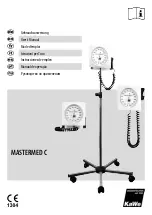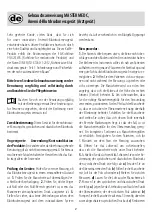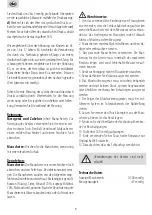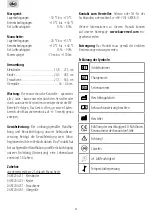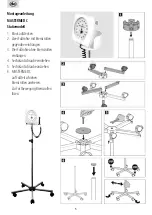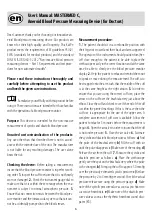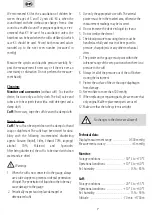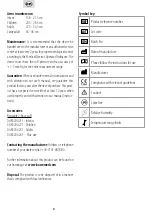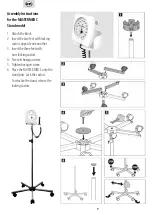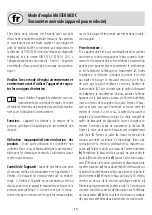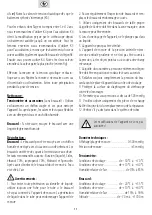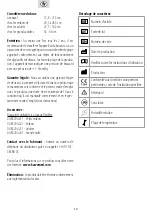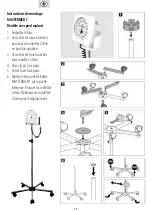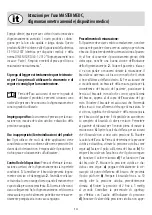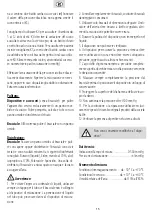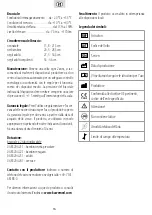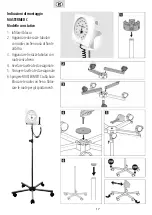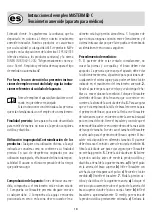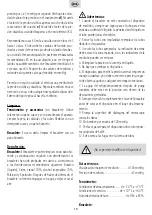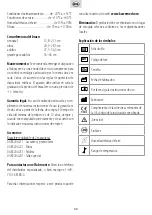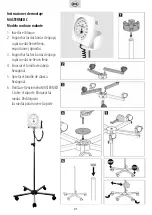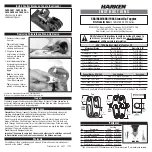
6
User’s Manual: MASTERMED C,
Aneroid Blood Pressure Measuring Device (for Doctors)
Dear Customer, thank you for choosing our innovative an-
eroid blood pressure measuring device. Our products are
known for their high quality and longevity. This KaWe
product meets the requirements of EC guidelines 93/42/
EWG (standards for medical products) and the standard
DIN EN ISO 81060-1:2012 “Non-invasive blood pressure
measuring devices – Part 1: Requirements and test proce-
dures for non-automated models”.
Please read these instructions thoroughly and
carefully before attempting to use this product
and heed the given care instructions.
Familiarize yourself fully with this product before
using it. These instructions are intended for those familiar
with the operation of a blood pressure monitor.
Purpose:
This device is intended for the non-invasive
measurement of systolic and diastolic blood pressure.
Unsuited use/contraindication of the products:
Any use other than that described here is not in accord-
ance with the intended use of the unit. The manufacturer
is not liable for any resulting damages. The user alone
bears the risk.
Checking the device:
Before taking a measurement,
insure that the blood pressure monitor is in perfect work-
ing order.
1.
Inspect the cuff to ensure that it is not heavily
worn or damaged.
2.
Check the instrument gauge dial to
make sure that it is within the zero range when the ma-
nometer is subject to normal atmospheric pressure.
3.
Ensure that no connection exists between the blood pres-
sure monitor and the intravascular system so that air can-
not be accidentally pumped into the blood stream.
Measurement procedure:
1.
The patient should sit in a comfortable position with
their legs not crossed and their back and arm supported.
The operator of the instrument should position him/her-
self close enough to the patient to be able to place the
stethoscope exactly in the correct location and at the same
time be able to clearly see the blood pressure monitor
display.
2.
Help the patient to relax and remind them not
to speak or move during the measurement. The cuff is to
be strapped onto the arm such that the middle of the cuff
is at the same height as the right atrium.
3.
In order to
ensure that you are using the correct cuff size, place the
arrow on the cuff over the brachial artery just above the
elbow. Close the cuff and check to see if the end of the cuff
is within the printed markings. If this is the case then the
cuff size is appropriate for the size of the upper arm. A
complete assortment of cuff sizes is available. Allow the
patient to relax for 5 minutes before the measurement is
begun.
4.
Open the air valve in order to insure that the cuff
is not under pressure.
5.
Close the air valve.
6.
Estimate
the systolic and diastolic blood pressure as follows:
a)
Find
the pulse of the brachial artery.
b)
Fill the cuff with air
until the pulse disappears.
c)
Make note of the reading.
d)
Release the air from the cuff.
7.
Measure the systolic and
diastolic pressure as follows:
a)
Place the stethoscope
gently over the spot on the brachial artery where the pulse
is the strongest.
b)
Pump up the cuff to approx. 30 mmHg
over the previously estimated systolic pressure.
c)
Reduce
the pressure by 2 to 3 mmHg per second. Check the actual
pressure release rate using the pressure gauge.
d)
Make
note of the systolic pressure value as soon as you hear two
successive heartbeats.
e)
Make note of the diastolic pres-
sure value as soon as the rhythmic heartbeat sound dissi-
pates (K5).
Summary of Contents for Mastermed C
Page 26: ...26 KaWe KaWe G93 42 EWG DINENISO81060 1 2012 1 1 2 MASTERMED C a 3 co 1 2 3 5 4 5 6 7 30...
Page 29: ...29 MASTERMEDC 1 2 3 4 5 6 MASTERMEDC...
Page 30: ...30...
Page 31: ...31...

